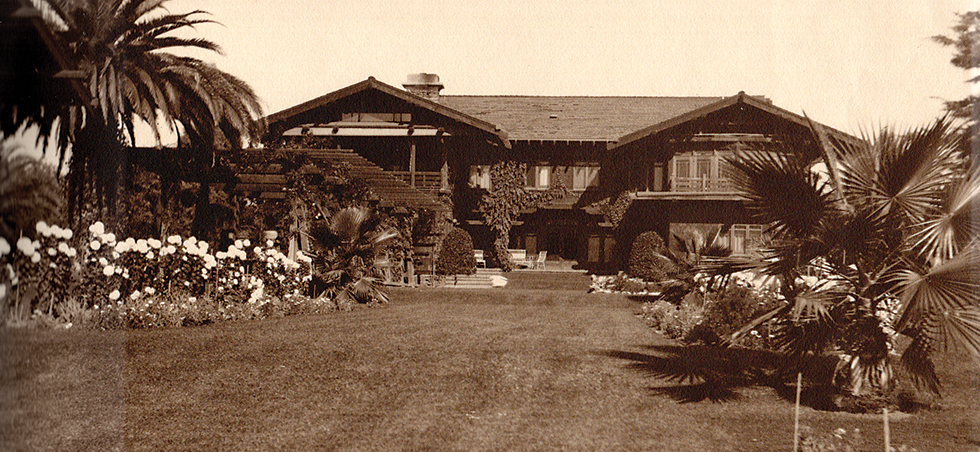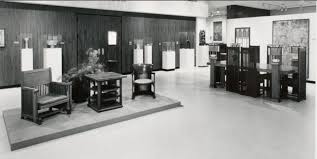ROBERT JUDSON CLARK PAPERS COME TO GREENE & GREENE ARCHIVES
by Ann Scheid ~
The recent gift of a collection from the papers of Robert Judson Clark, noted scholar of the Arts and Crafts movement, has greatly enriched our Greene and Greene Collection. Facilitated by Gamble House director Ted Bosley, who received the papers from Clark’s widow, Nancy, the gift consists of research files containing many rare items. Clark, a professor at Princeton, was the first to take a comprehensive look at the American Arts and Crafts movement with an exhibition at Princeton in 1972. The exhibition and its catalogue (The Arts and Crafts Movement in America 1876-1916) introduced a host of important figures and their work to a wider public, including Californians such as the Greenes, Ernest Batchelder, Dirk Van Erp, and Lucia and Arthur Mathews. Two years later, the California Design exhibition in Pasadena and its catalogue, California Design 1910, widened that scope to add impetus to the Arts and Crafts Revival movement started by Clark.
Clark’s files are a treasure trove of research material, documenting the major and some minor or lesser-known buildings by the Greenes with photographs, copies of popular and scholarly articles, clippings, brochures, and research notes. Annotated in Clark’s hand, the files provide a window into his ideas and interests as well as valuable original source material on the Greenes. In some cases, Clark was able to interview the original clients or their relatives, as well as servants, artisans and construction workers who had worked for the original clients. These interviews provide further information about the genesis of the design and construction of the buildings.
A meticulous scholar, Clark conducted exhaustive research and unfortunately published all too little. His major project, a book-length study of the William R. Thorsen house (Greene and Greene, 1909) in Berkeley, where Clark was an undergraduate and later taught, was never completed. Almost half of the five boxes of material contain files on the Thorsen house, including drafts of the proposed chapters of the book. Clark had cultivated a close relationship with the Thorsen family in the course of his research, and his papers contain many items that could have only come from the family.
Probably the most valuable item in the collection is a series of ledger sheets from Thorsen family records documenting the construction of the house. Here we learn that the house, begun in April 1909 and finished in November 1910, cost a total of $75,788 and that the Greenes were paid $3,635 for their services (approximating the usual fee of 6%). We also learn that W. J. Ott, the contractor who had supervised the construction of the Blacker house in Pasadena, performed the same task in Berkeley (at $36 a week), and that Peter Hall, hired for the interior finishing work on the Blacker project, worked on the Thorsen house as well. Familiar names on the list associated with other Greene and Greene projects include Emil Lange, Gladding McBean, Cobbledick Glass Co., Simons Brick Co. (of Pasadena), Munger and Munger (a Pasadena plumbing company), and W. H. Hough, who did the oil finishing and painting on the Gamble house. Aside from the many interesting details about the specific project, this complete account of building activities and expenses is a valuable resource documenting construction and labor practices common in early twentieth-century California.
In addition to his research on the Thorsen house itself, Clark researched its context, collecting information about the neighborhood and other bungalows in the area as well as about Bay Area architects such as Bernard Maybeck, Julia Morgan, A. C. Schweinfurth, Willis Polk, and others. Exploring these files will certainly turn up more valuable information on these subjects.
Not surprisingly, a number of rare items relating to the Blacker house are in the Clark papers. Caroline Thorsen, Nellie Blacker’s younger sister, was inspired by Nellie’s Pasadena house to hire the Greenes to build her house in Berkeley. Clark’s files contain materials about the Blacker house that must have come from Caroline. Most exciting is a unique tinted photograph of the Blacker house by the Greenes’ official photographer, Leroy Hulbert, as well as several original prints of Hulbert photos available only in the Avery Library at Columbia University. In addition there are other previously unknown photos of the Blacker house and its garden.
Clark’s files on the Greenes’ work include many photographs by Clark himself, who began his research on the Greenes sometime in the 1950s. His photos of the Pratt house show the furniture, both in its original locations in the house as well as outdoors to take advantage of daylight conditions. Several photos of the long-gone Libby house and its garage (demolished 1968) on Pasadena’s Orange Grove Boulevard add to the almost non-existent visual record of the house, one of the Greenes’ Craftsman chalets. Clark’s square-format snapshots of these and other houses are carefully mounted on heavy dark paper, and because they are so early provide important clues about the landscaping and other features of the houses in the 1950s and 1960s, when they were beginning to be re-discovered by followers of modernism.
Besides Clark’s photographs, his papers also contain the work of professional photographers, notably a series of prints of the Pratt house by well known San Francisco photographer Roy Flamm. Flamm’s work augments the large collection of photographs by William Current already in the Greene and Greene Archives as well as the Huntington’s collection of images of the Greenes’ work by Maynard Parker, subject of a new book from Yale University Press, which includes an essay by Ted Bosley.
Clark was fond of searching out possible sources for the Greenes’ designs, and there are many examples in his files. He includes an image of the 16th-century fountain in front of the Casino (garden house) of Pius IV in Rome, nearly a dead-ringer for the simpler fountain designed by Charles Greene for the Blacker house garden. Using a pen to ink out some of the mullions in a photograph of a door at Frank Lloyd Wright’s Imperial Hotel in Tokyo, Clark points out its similarity to a door designed by Henry Greene at the Pratt house. In the Fleishhacker file Clark collected photos of Italian Renaissance gardens, as well as a garden folly representing the ruins of a Roman aqueduct at Schwetzingen Palace in Germany, all showing striking similarities to the arcades by Charles Greene in the Fleishhacker garden.
Another byway in Clark’s research shows his interest in the history of the automobile’s effect on suburban design. Thus there are articles in his files on how to design driveways and garages on suburban lots, including an article from an obscure publication, Keith’s Magazine (1914), with a hitherto unknown photo of the Gamble garage.
All this and more make the gift of the Robert Judson Clark papers significant for anyone interested in further study of the Greenes’ work. ♦


